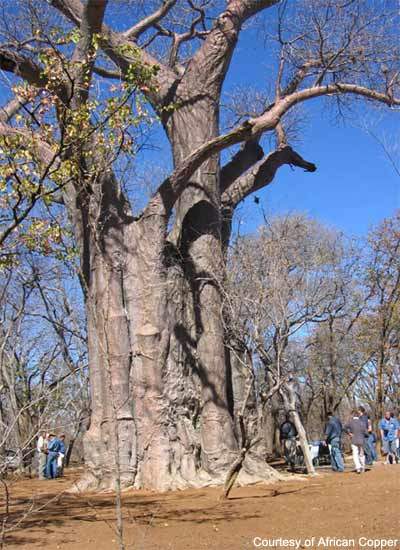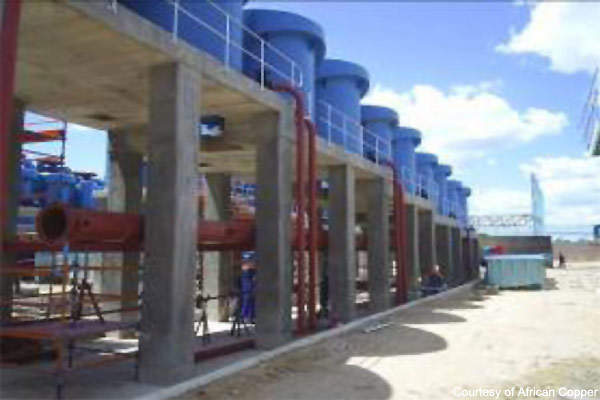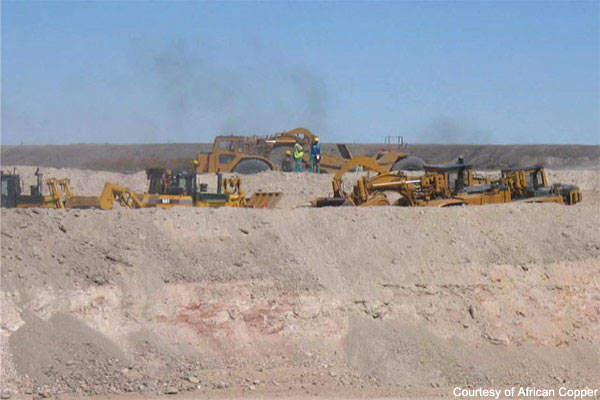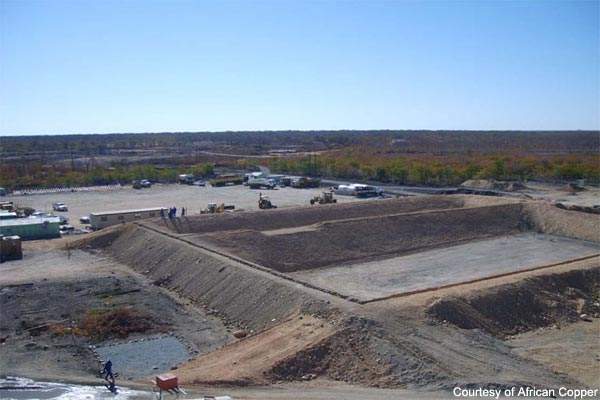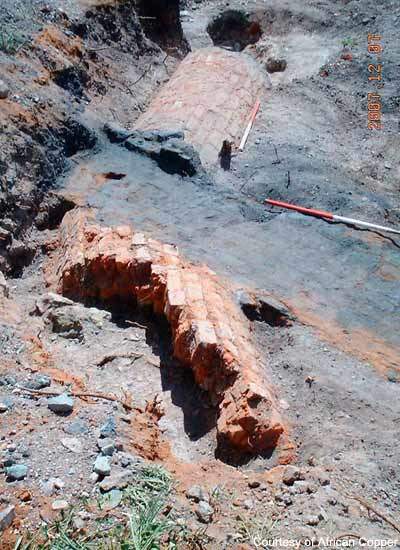African Copper is developing its first copper project – the Mowana mine – at the Dukwe project in north-east Botswana, and anticipates production in the second quarter of 2008. The Mowana mine offers African Copper near-term production from an open pit, with the potential for future underground expansion.
The company was granted a 25-year mining licence at the end of 2006 which, during the first quarter of 2007, was expanded to include a 5km area of influence along the strike extent of mineralisation around the mining area, an expansion from the original 2km area of influence.
Under existing EIA and EMP permits, any material found in this expanded area may be brought into the mine plan without the requirement for additional permits.
In addition, the company has the approval of the Environmental Impact Assessment (EIA) and the Environmental Management Plan (EMP), water abstraction rights and a conditional archaeological discharge for the site. As a condition of the licence, the project will be subject to a 3% royalty payable to the government of Botswana.
FINANCE
The total capital cost for the processing plant and related facilities is estimated to be approximately 464.5m South African Rand (ZAR). In addition, pre-production capitalised mining expenditure for the open-pit is being estimated at ZAR200m. Working capital is estimated to be approximately ZAR47.0m.
The company completed its initial offering in 2004, which raised about $30m, then in May 2006 another $110m was raised and in June 2007 a private placement raised a further $15m.
In January 2008, the company finalised an offtake agreement with MRI Trading AG of Zug, Switzerland, for the concentrates. The agreement is for five years, is renewable and covers 100% of all copper products shipped from Mowana. In conjunction with the agreement, MRI took 7,284,000 ordinary shares in African Copper, roughly a 5% equity position, for $10m.
Finally, in March 2008, the company raised Pula 150m (£11.4m) in an unsecured debt financing to Botswana-based institutions. The bond is denominated in Pula and is an unsecured fixed rate note.
GEOLOGY
On a continental scale, the Matsitama Supergroup which hosts the Dukwe deposit and the Mowana Mine lies within a PaleoProterozoic sedimentary basin of the southern African Shield. The supergroup has been metamorphosed and deformed in an orogenic event, which structurally placed the sedimentary and volcanic sequence over the older granite-gneiss terrain along a series of thrust and nappe surfaces.
The Dukwe deposit is an epigenetic quartz-carbonate vein hosted copper deposit. The mineralisation lies within a near-vertically dipping thin, linearly extensive belt of the early Proterozoic Matsitama Supergroup meta-sedimentary rocks. They are enclosed by sheared granite-gneisses and granites of the Mosetse Complex within the broader structural domain of the Bushman lineament. The metasedimentary rocks and the enclosing granite-gneisses have been flattened, elongated and attenuated within the Bushman lineament shear zone.
The primary sulphide consists of chalcopyrite mineralisation within a complex assemblage of quartz-calcite veins, breccias and carbonaceous calcareous sediments developed within a limestone horizon of the Matsitama Group sediments. The near-surface parts of this zone have been enriched in a supergene blanket, while the parts closest to the surface have been oxidised with the development of copper-carbonates and copper-oxide minerals.
Copper oxide mineralisation extends from the surface to a maximum depth of about 70m. The supergene chalcocite mineralisation is progressively oxidised towards the surface with the development of the copper-carbonates, such as malachite and rarer azurite; copper-silicates such as chrysocolla, together with very minor native copper and copper oxides, such as cuprite.
Chalcocite supergene copper mineralisation is developed over depths ranging from the surface to 150m below the surface. Chalcopyrite-bearing hypogene mineralisation lies below the oxide and the supergene copper mineralisation.
RESERVES
Total measured and indicated reserves for the Mowana mine are 87.67 million tonnes of copper grading at 0.71%, including total proven and probable reserves for the open-pit standing at 14.8Mt at 1.11%. In addition, inferred mineral resources total 46.27 million tonnes of 0.63% copper. Since most of the Mowana resources are not within the open pit, the company has commissioned a pre-feasibility study to investigate the viability of an underground mine. The results of this study are expected soon.
Mixed oxide-supergene and supergene ores comprise 35% and 45% respectively of the open-pit reserves, with the sulphide ore contributing the remaining 20%. Production from the open pit will come mainly from this material, and will cease after 2014, when mainly sulphide ore will be extracted from underground
PRODUCTION
Production at Mowana is expected to grow from 5,500t of copper in 2008 to 29,000t in 2012. The process plant at the mine has been designed for a 3,000t per day throughput of oxide, supergene and sulphide ores.
PROCESSING
Although the Mowana ore body is amenable to open-cast as well as underground mining, the vertical orientation of the mineralisation results in high strip ratios that limit the maximum depth of the open pit. Consequently, the main target of future mining is the deeper sulphide ore.
The process plant design is based on early production from open-pit mining. A three-stage crushing circuit has been designed to deliver -15mm material to a mill stockpile. A 120tph ball mill will be used to grind ore to -150 microns.
Using a Dense Media Separation (DMS) plant, which will be incorporated in 2010, the run-of-mine ore will be separated into two streams – one-third high grade; two-thirds low grade. The high-grade ore will pass through a crusher directly to the flotation plant. The low grade ore will pass through a separate crusher and upgraded in the DMS plant before proceeding to the flotation plant.
The process plant also has two floatation circuits. Sulphide minerals are separated first, and tailings from the sulphide roughers are sent to an oxide circuit. Most other mineral species are recovered in the oxide flotation process. Depending on the mix of oxide and sulphide minerals, overall recoveries range from an estimated 44% (pure oxides) to 93% (pure sulphides).
Concentrates are filtered to recover excess process water, as are tailings, which will be dry stacked. Water recovered in the de-watering stages will be recycled to the various parts of the plant as process water. Water for the entire plant will be supplied from well fields about 13.5 km. north of the site. A raw water pond will allow for three days’ retention time to enable ore processing in case of borehole failure.
The mine already has a full shovel fleet and 14 haul trucks are on site, and it is expected to employ 175 by the end of June 2008.
South African-based RSV Engineering Inc is the lead engineering company and has supervised the construction of the infrastructure, project management and engineering company Senet, of South Africa, has supervised the building of the processing plant – these two are the EPCM contractors – and Turgis Consulting (Pty) Ltd, also of South Africa, has designed the open pit.

